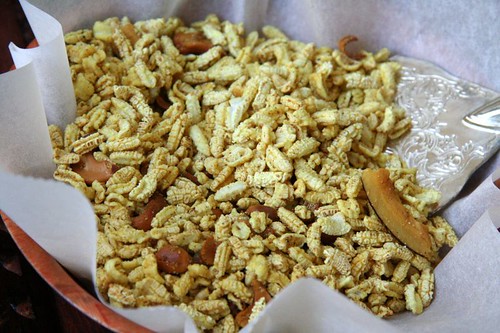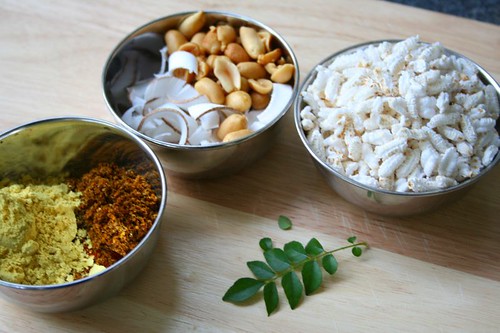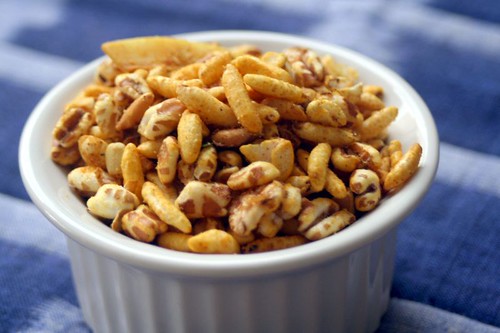A recent invitation to a housewarming party said 'no gifts please'. While I appreciate the sentiment, I have known the hosting family for a long time, and hadn't met them in a while, so I just didn't feel it was right to go there empty handed. I decided on taking an edible gift instead, in place of an unwanted trinket that they were probably trying to avoid.
I thought of muffins or some kind of breakfast bread that they could have the next day, but wasn't sure if they ate eggs, so dropped that idea. They would also in all likelihood have some food leftover from the party that day, so I thought perhaps something that would last a little longer would be better. Something old-fashioned, but familiar, something healthy, but delicious, and with this list of criteria, I zeroed in on chiwda, more specifically lahyancha chiwda. It is much quicker to make than the traditional Diwali chiwda that I make annually for Diwali (of course) and all the ingredients needed for this chiwda were already at home.

Lahya (plural) is the marathi term for popped grains. The original recipe called for popped jowar (jondhalyacha lahya), but I have not seen those here. The popped rice lahya on the other hand are found quite easily in Indian grocery stores, and in giant big bags too, referred to as puffed paddy. This nomenclature doesn't sound right to me, because puffed paddy could also apply to regular kurmure that are used to make bhel, but that doesn't bother me. It is the store strategy of packing things in giant bags and thus forcing me to buy more of what I need that is actually very annoying.
This chiwda is adapted from a recipe in Ruchira, and needs two uniquely maharashtrian ingredients - goda masala and metkut, that together impart a wonderful taste distinct from the regular chiwda. Metkut is a multi-purpose powder made out of various grains and spices, and is one of the many things that I have never made myself. I bring a packet of metkut made at home every time I go to India, and it usually lasts in the fridge well until my next trip back. Metkut is also increasingly available now in well stocked Indian grocery stores in the US. If you cannot find it here, of course, you can look for it when you travel to Maharashtra. In Bombay, you will need to head to a store that is geared towards a more niche marathi clientele.

Spices, Nuts, Lahya, Curry Leaves
Before making the chiwda, check to see if the popped rice is crisp and crumbly. If not, spread it out on a cookie sheet and keep in a low temperature oven (between 150 and 170) for about 15 minutes, until the grains can be crumbled by just pressing it between a finger and thumb. This method works for me, but the grains available here could vary in quality.
Ingredients
6 cups of lahya (popped rice or jowar), crisped in the oven if required
4 Tablespoons oil
1/2 teaspoon mustard seeds
pinch of asafoetida (hing)
1/2 teaspoon turmeric
10-12 curry leaves
1/2 cup peanuts (or cashewnuts, or a mix of both)
1/2 cup coconut curls
1 teaspoon red chili powder (or to taste)
1 teaspoon coriander powder
1 teaspoon cumin powder
2 teaspoons goda masala
4 teaspoons metkut
2 teaspoons granulated sugar
1 teaspoon salt (or to taste)
Method
Mix the chili powder, coriander powder, cumin powder, goda masala, metkut, sugar and salt in a small bowl.
Heat the oil in a large wok, kadhai, or Dutch oven. Add the mustard seeds, and when they start to pop, add the asafoetida, turmeric, curry leaves, and the peanuts. When the peanuts are almost fried in the oil, add the coconut curls, and when they start to turn golden brown, take the wok off from the heat, and let the oil cool slightly.
Stir in the remaining dry spices into the oil, and then add the popped rice to it, and using a large spoon mix until the grains are coated with the spice and oil mix.
Let cool completely before eating, and store the remaining in an air tight containers. It can last for several days.
Notes
- This is a moderately spicy chiwda, so reduce the amount of chili powder if you like it mild.
- Keep the chiwda slightly undersalted when you make it, as it tends to absorb the salt in about a day.
- Metkut often has salt added to it, so make sure you adjust the quantity of salt according to how salty the metkut is.
An Alternative to Popped Rice
I have also made this chiwda using Kashi Wholegrain Puffs, and it tastes just as good. The story goes that I bought the cereal while on a virtuous eating mission, but did not like it at all as a regular cereal with milk. So something had to be done with it, and turned to this chiwda formula to take it from blah to ah!




























18 comments:
Chivda would soothe my soul, after those heavy party foods. Its a piece of home. I am sure they would have loved it.
wow! metkut in chiwda, that sounds like a lovely combo :)
have not had lahya in a long time, but i remember eating it as parshad, it used to be a sweet version with some batashe thrown in :)
those spices sure will awaken the blah cereals.....lol
Gimme some! Spicy is good for me :-D. And you find metkut here! Wow!
I didnt know we get lahya here. Honestly this is a new recipe for me. I have always had lahya in a sweet mix - panchkhadya. Never in a chiwda. It sounds fabulous with methkoot and all.
Zhakaas!
Metkoot and masala must've made it bhadanga-like.
Recently I made chiwda using whole-wheat rice cripies. Seemed like a good idea, but in reality it just didn't come together as expected. Will try these puff next time. Merci.
We use this popped rice during diwali pooja. Also during marriage, when the bidaai ceremony is going on, the dulhan throws this behind her, while going out, thus symbolising that her parents house should always be full of happiness and there should be no shortage in their house.
Oh and the chivda looks great.
Suganya, I sure hope they enjoyed it.
Richa, when I saw the recipe the first time, metkut in chiwda was new to me too. And yes, lahi-batashe is the classic prasad for laxmi pooja, which is how the lahya first landed at home. Then with the huge quantity leftover I had to look for ways to do something with it. Once I made the chiwda, I started buying the lahya just for that!
musical, all yours! Extra spicy if you like.
Ashwini, yes you do get them here quite easily.
TheCooker, yes, it is somewhat like bhadang, but different. btw, someone once gave me real bhadang from desh (not kurmura) which I used to made the bhadang from Ruchira and it totally rocked.
vimmi, thanks for the interesting information, and welcome to my blog too.
In a certain region of Andhra, this popped rice is used to make papads, they're really tasty! I've seen this in Orissa too, bound by jaggery.
I make lahyancha chiwda to use up all the lahi leftover after Divali puja...but use the regular recipe...this looks so much more interesting with metkut and goda masala! Gotta try it this Divali ;-).
Yumm!! Love chivda and ur version is different!!! Gimme some!!
I'm a chiwda fan.. Love your chiwda. thanx for sharing...
sra, those papads sounds so good. It is so interesting to hear how much this popped rice is used in rituals and ceremonies in different ways in different regions.
Anita, oh cool, you make the chiwda too! The metkut and goda masala certainly give it, what should I say, 'je ne sais quoi'.
Manasi, all yours. It is different from the regular one in a good way.
Thanks Rina, and welcome.
All very new to me. Thanks for the education.
Looks great! Yes, this is khoi :-) BTW, I think lahya/khoi would be technically popped paddy as this is prepared from the non-dehusked grains (paddy or dhaan). Muuri/kurmure would be popped rice where you use the dehusked rice grains.
This looks so very good!
Cynthia, you are most welcome.
ns-jee, thanks for confirming that this is khoi! Popped paddy makes sense too - I didn't know that the lahya were made with the unmilled (non-dehusked) grains. As for muri, while they might be popped, has puffed rice just been incorrectly prevalent for a while now? Never thought about that.
vegeyum, thanks for the compliments.
I closed my eyes and felt for the aroma. Good post, indeed.
Thanks Anamika.
Post a Comment